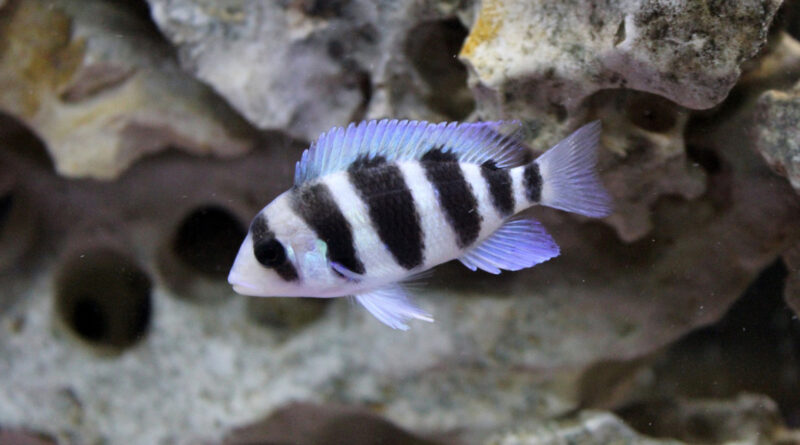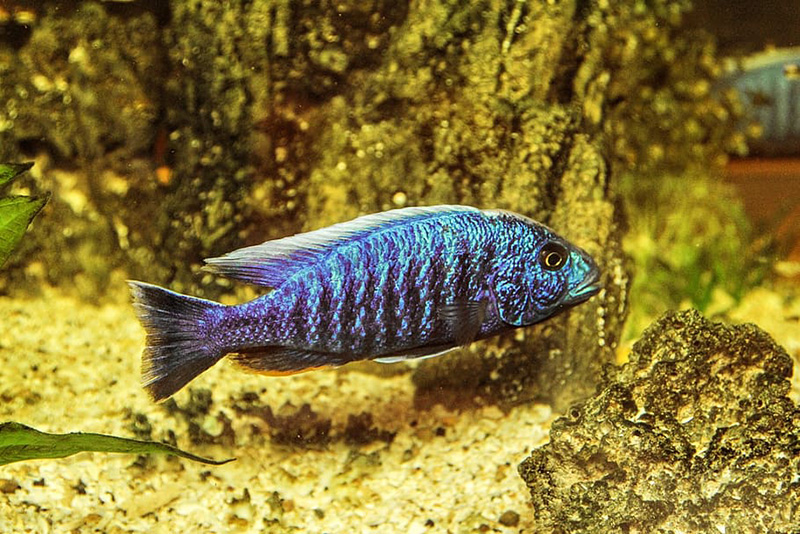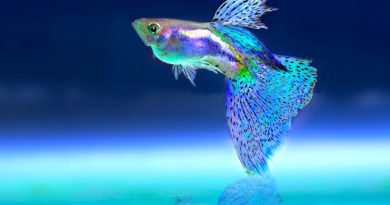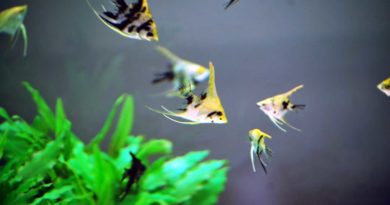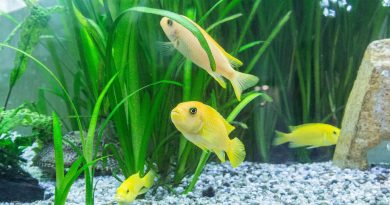Different types of cichlids you must know
There are various different types of cichlids in the world of freshwater aquariums. Cichlid fish are various looking aggressive fish from one family.
They are a group of different fish from the family Cichlidae (scientific name).
They are looks different from each other by their look and size.
In this article, you can read about some of the cichlid species that are become popular aquarium industry all the time.
Cichlid fish in detail
There are various types of cichlids. They are also aggressive freshwater aquarium fish at different levels.
One of the main reasons Cichlids become popular with aquarists is that they look so colorful and beautiful.
Since the name “Cichlid fish” is used to represent a fish family, there are various different sizes and shapes of cichlids types.
If you love aggressive fish types, Cichlids are a perfect match for your fish tank.
Even though they are aggressive over other fish and sometimes over them as well, people love them because of their attractive look.
Cichlid types are native to North, Central, and South America, and Africa. African lake cichlids are one of the most popular varieties.
You must see in aquarium stores, that there are cichlid fish types such as South American cichlids, Lake Malawi Cichlids, and Tanganyika cichlids so on.
There are also some other classifications found like dwarf cichlids, Central American cichlids, docile cichlids and etc.
Usually, a normal cichlid fish will not grow over the 12 inches and the aquarium cichlid fish types normally have a rounded tail.
Even though we imagine beautiful yet aggressive fish as Cichlids types, there are some that are less aggressive as well.
Since the original purpose of this article is to discuss types of cichlids, let’s move to that section.
The various types of cichlids
There are a lot of different cichlid species in the world. But not all are suitable for aquariums.
In this section, you can read about some cichlids species that are known as the best for aquariums.
The Electric Blue Cichlid
As in the name, this cichlid species have an electric blue color in them. This color is hard to find commonly in aquarium fish types.
The Scientific name for Electric blue cichlid is “Sciaenochromis fryeri”.
This type becomes eye-catchers. They have an aggressive look with bright colors which is a perfect match for a cichlid.
This is one of the popular Malawi cichlids. If you are thinking of setup a Malawi fish tank, this cichlid fish should be a tank mate of your tank.
When talking about the tank setup, a sandy substrate and rock-based background are the best for them.
This fish can get stressed easily, so having multiple females for a male cichlid fish is a good idea. That also helps in breeding them.
This cichlid fish type is not one that hard to keep. But also they cant be categorized as easy. So the care level for this is Intermediate.
The temperament of this fish is also at an intermediate level. they are not highly aggressive but should not keep with smaller aquarium fish types.
The electric blue cichlid needs to have a minimum of 70 Gallons of tank size with hard water and high pH.
The Peacock Cichlid
If you are a Lake Malawi fish lover, This cichlid variety should be on your list as one of your priorities.
They are amazingly colorful and one of the most beautiful types of cichlids. The male fish is more beautiful and with a mixture of colors.
This fish is known as the Malawi butterfly in some regents. But the common name for them is the Peacock Cichlid.
The Scientific name for Electric blue cichlid is “Aulonocara jacobfreibergi”.
When talking about the tank setup for Peacock cichlids, having a sandy substrate is good for them than a gravel substrate.
They also need to have hard water with a high pH level. And also you can add some planted background for them.
When talking about the care level, they are also in the middle which is Intermediate.
The temperament of this fish is known as moderate. Also, they need at least 50 Gallons of a fish tank to live on.
Yellow Lab Cichlid
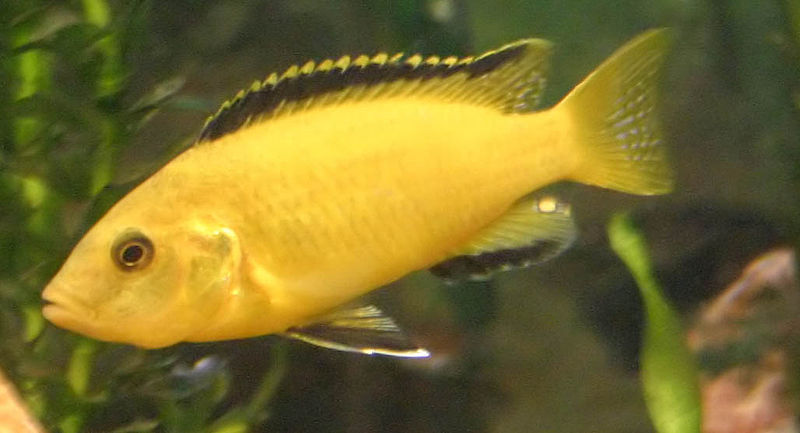
This is another lab cichlid that you must love. They have an amazing bright yellow color which is looking really beautiful.
If you add them to your fish tank, the Yellow Lab fish cichlid will be one of the best eye-catching fish in your cichlid fish tank.
Lake Malawi fish lovers always love to have the Yellow Lab as a tank mate in their fish collection.
The Yellow Lab fish is another popular and common lake Malawi fish in cichlid aquariums.
This cichlid species is also known as the mouthbrooding electric yellow cichlid in some regents. The scientific name for this fish is “Labidochromis caeruleus”
If you are like to keep them in your fish tank, they love to live on a sandy substrate with some rock-based backgrounds.
If you think about the behavior of Yellow Lab Cichlid, they can be aggressive but within their limits. so they are not too aggressive.
When talking about the difficulty level, this cichlid variety is easy to keep and easy to care for.
You must have at least a 40 Gallons fish tank to give Yellow Lab cichlid fish a good environment to live in.
Discus fish
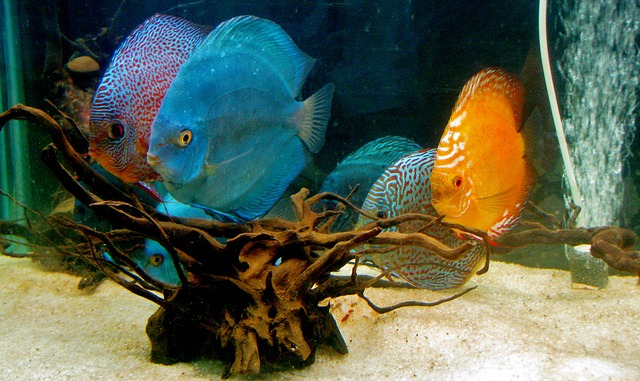
I am so sure, you know about them very well. The Discus fish is also known as the King of the aquariums by some aquarists.
Even though you know them very well, you might didn’t know Discus fish also from the cichlid fish family. They are one most popular cichlid fish types these days.
In some regents, they know as Disc fish, king of the cichlid as well. The scientific name for the Discus fish is “Symphysodon genus”.
This is one of the most popular varieties of the cichlid. They have various colors and patterns with many categories. You can read more about them here.
Discus fish are quite beautiful in shape, size, colors, and patterns. But also, they are difficult to care for. They need their own requirements when living in a fish tank.
This cichlid fish variety is love to live in a planted-based aquarium. So adding some aquarium plants will be good for them.
Trust me, if you have them you will watch hours of their lovely calm movements and beautiful attractive look. They are making your aquarium an attractive one.
Even Discus fish a popular member cichlid, The temperament of the fish is semi-aggressive and they required calm and peaceful tank mates. But avoid adding smaller fish like guppies.
This fish required at least 40 Gallons of fish tank for a pair of them with some soft considerable warm water.
Freshwater Angelfish
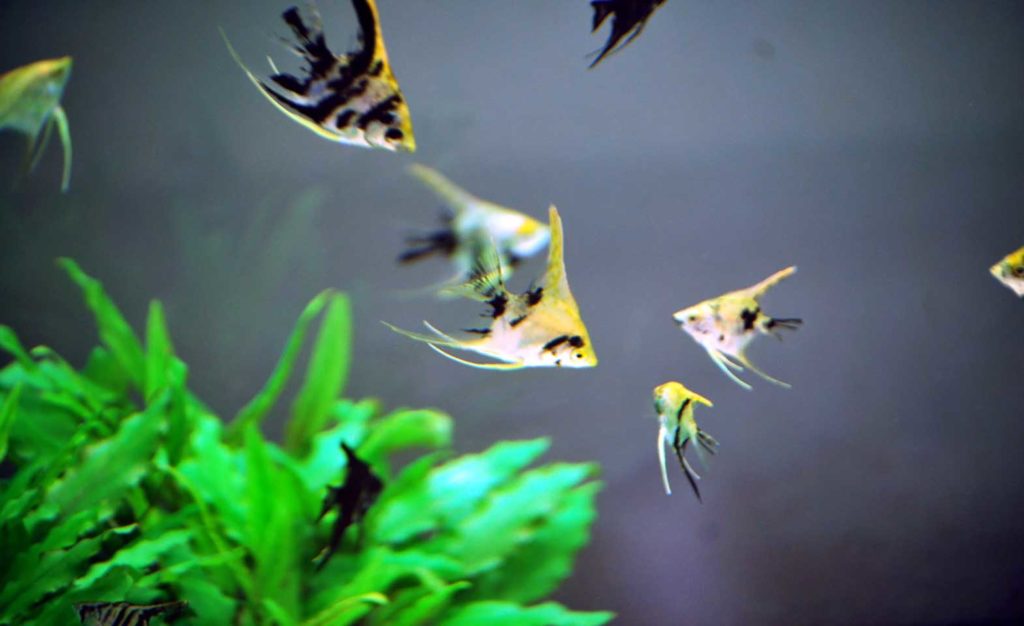
Another highly popular freshwater fish variety from the cichlid fish family. This is a very common fish in most freshwater fish tanks.
There are several different types of Angelfish we can see in freshwater aquariums. Also, there is another type of Angelfish we can see in saltwater aquariums as well.
This fish is also one of the most commonly used cichlid fish varieties. That means, the Angelfish also have some behaviors of cichlids. The scientific name for them is “Pterophyllum genus”
They have their unique shape and there are some varieties such as vail tails, short tails, etc. When a group of Angelfish is together it gives an amazing look to your fish tanks.
They are basically not that aggressive but can be a bit aggressive over some fish types. it’s based on the environment they live in.
Adding more than a pair is a good idea. But in my personal experience, I have seen that they are sometimes getting aggressive over them as well.
The Freshwater Angelfish cichlid also loves to live in planted-based fish tanks. They also look awesome in a green environment.
When talking about the difficulty level, there are not that hard to keep, but they need their conditions as well. So you can take as the difficulty level intermediate for this fish.
A minimum of 40 Gallons of fish tank with calm tank mates is ideal for Angelfish cichlid with some planted and wood environment.
Convict Cichlid
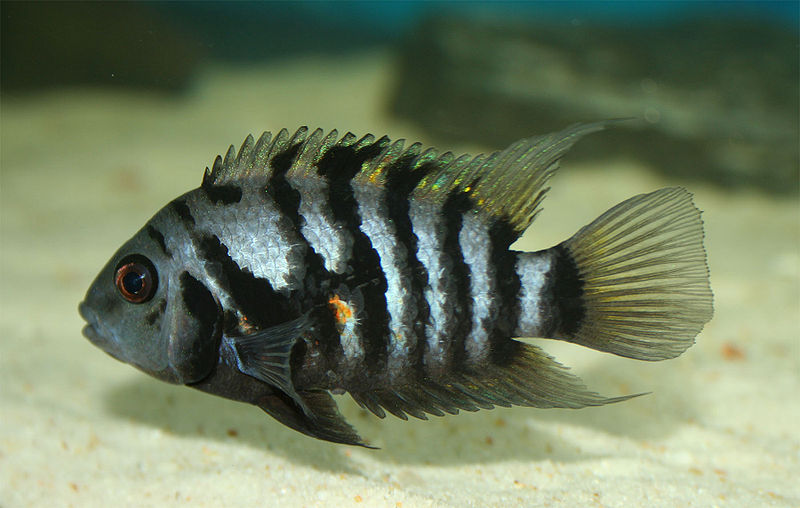
When it’s about cichlids, the Convict cichlid fish is always coming to my mind. This is another highly popular type of cichlid that can see in many countries.
This is an American cichlid variety, And a good choice if you thinking to maintain a cichlid fish tank. The scientific name for this fish is “Amatitlania nigrofasciata”
The Convict cichlid is known as one of the aggressive types of cichlids, So don’t add them into your community fish tank.
Even though they are aggressive, this cichlid fish type is a good fish for beginners as they are really easy to keep. If you are a beginner, bingo! you found a good beginner cichlid fish to start with.
But, if you need to keep a group of them, you have to prepare your tank for that as they need their own territorial spots. For this, you can add rocks, woods, and any other hiding spots.
They are ok with plants, so you can add a few plants, kinds of wood, and rocks with them to give a better life to your Convict cichlid.
This aggressive cichlid variety needs at least 30 Gallons of a fish tank to live as pair. Don’t forget the golden rule that is, if you need more of them, your tank must have more space.
Oscar fish
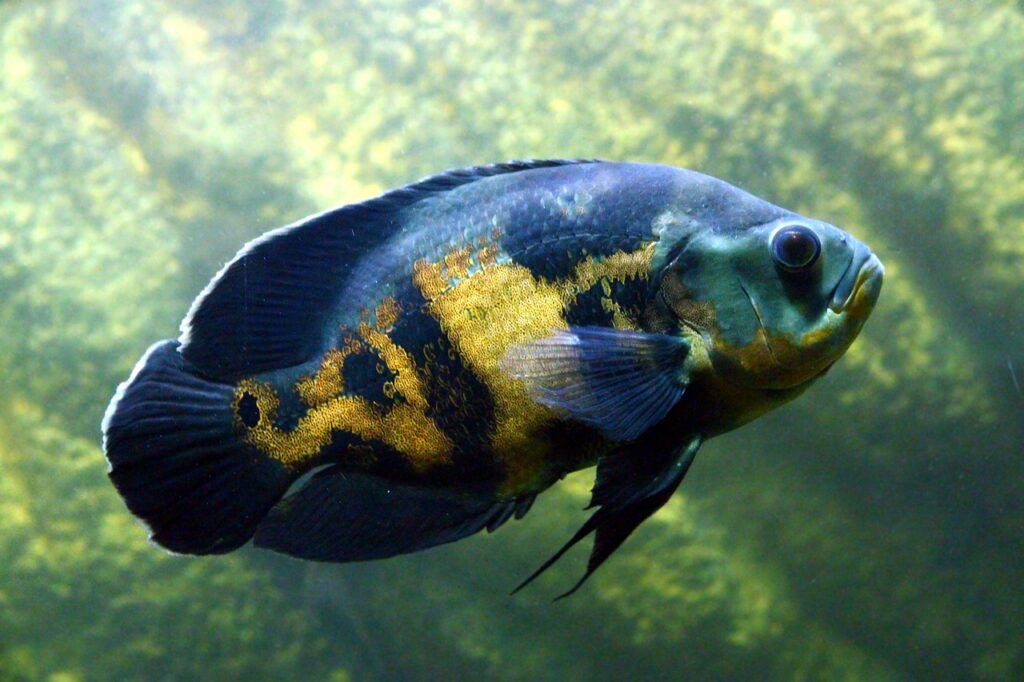
If you are like to keep bit bigger cichlid fish in your fish tank, the Oscar cichlid fish will be an ideal choice for you.
The Oscar cichlid fish grow up to a large size when compared with most other types of cichlids. They are also one of the most popular cichlid species out there.
The scientific name for the Oscar fish is “Astronotus ocellatus”. There are a few different types of Oscar fish as well.
Not just the size of these fish makes them popular, They have their unique color patterns as well. That makes them really beautiful and unique.
Oscar fish is not that aggressive, but they can be aggressive depending on the mood and situation they are in. I would advise NOT to add smaller fish types with them.
An adult Oscar fish will grow up to 12 – 14 inches. Yes, I guess you got it. That means the Oscar cichlid needs a bigger tank compared to most of the cichlid fish types.
They need at least 120 Gallons of the fish tank to live in. This size of a tank is just for one pair of Oscar cichlid fish. If you need to keep several Oscar fish together, You need to have enough space in your fish tank as well.
When considering the fish tank environment, a fish tank with some plants, driftwood, and rocks is a good choice for the Oscar fish.
Jewel cichlid
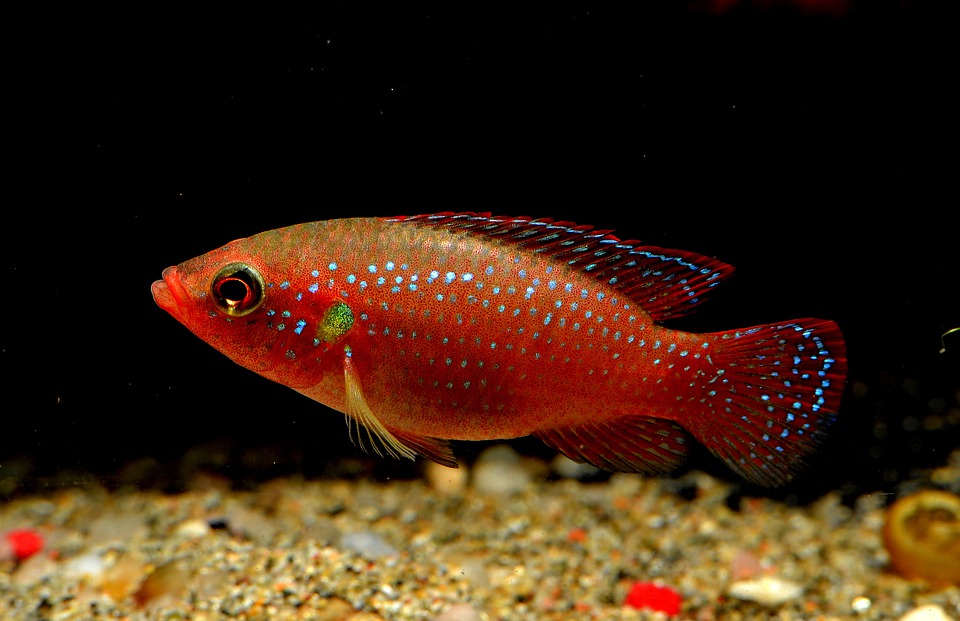
If you like to have a cute cichlid in your fish tank, the Jewe cichlid is one of the best for you.
This is an African cichlid species. The scientific name for this type of cichlid is known as “Hemichromis bimaculatus”.
Thes type of cichlid is not good for a community tank as its aggressive nature. They can be very aggressive sometimes.
A correct pair of Jawel cichlids can live peacefully, Don’t for to add some hiding spots and sandy substrates for them.
These cichlid fish have a habit of digging, So giving them sandy substrates will help to reduce their stress and et they have their natural life.
Also, you can have some plants in your fish tank with them. They don’t need a heavily planted tank but they like to live with some plants.
This fish is very aggressive so they are not good for beginners. The difficulty level is known as intermediate for Jawel fish.
It is enough a 30 Gallons of fish tank for a pair of Jawel cichlid fish with the above substrates.
Firemouth cichlid

Another highly popular cichlid from the cichlid fish family. They are not as colorful as most of the other cichlid types.
This is a Central African fish and highly popular there. The scientific name for Fire mouth cichlid is “Thorichthys meeki”.
When comparing the size, this cichlid fish type is a larger one. Yet they are not hard to keep in a fish tank.
Also, they are not that aggressive, but they love to keep their territorial places in the tank and can be harmful full some smaller fish as the Fire mouth cichlid is a bigger cichlid fish.
A minimum of 40 Gallons of the fish tank is enough for them with some hiding rocks and plenty of driftwood.
It’s not hard to keep them in a fish tank as they are ok with most of the normal water conditions.
Frontosa cichlid
If you are like to have a beautiful stripped cichlid fish in your fish tank, The Forntosa cichlid (Cyphotilapia frontosa) is one of the best for you.
This is a lake cichlid fish but does not belong to the Lake Malawi fish family. The Frontosa cichlid is a lake Tanganyika.
When considering the look, as I have mentioned before, they have some black stripes in their white, blue mix body.
These looks make them look outstanding in a freshwater aquarium. Also, they have some white and blue mixed fins with a beautiful look.
If you are going to have this cichlid fish type, You must have enough space in your aquarium for them.
And you should have at least five of them in a group with more females. That will reduce their stress and unnecessary aggressiveness.
This fish is in the intermediate difficulty level and they are mostly calm but not with all the fish varieties.
As I mentioned the Frontosa Cichlid needs enough space in your fish tank, the space is minimum a size of 200 gallons of a fish tank for them.
The Conclusion
This article if shares some information about the 10 different types of cichlid fish that we can add to your aquarium.
Some fish types are the best cichlids for beginners while some cichlids are not good for beginners.
I have talked about some of the African cichlid types with pictures of them as well as Lake Malawi types, and Asian cichlid types as well.
This is the end of this child fish article but I am thinking to add a few more articles based on the cichlid fish details. So if you are reading this, I recommend checking the website for the other cichlid fish articles as well.

